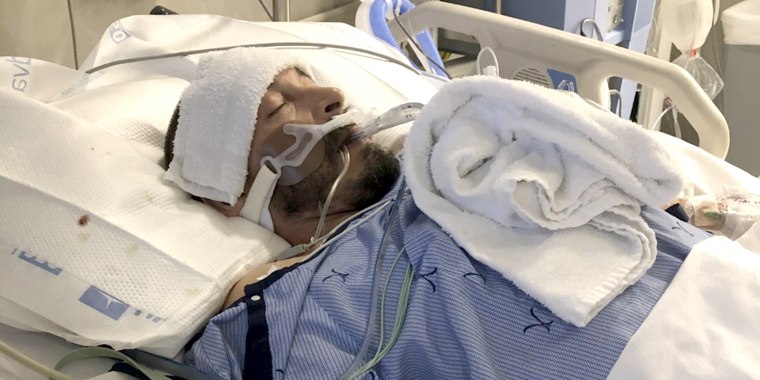It was early afternoon on Valentine’s Day when Tamas Kalmar started having trouble breathing.
The symptom came out of the blue — he was at home in Las Vegas where he’d been working on his motorcycle. There was nothing strenuous about the activity, yet he couldn’t catch a breath.
“It was like somebody grasped my lung and wouldn’t let go,” Kalmar, 49, told TODAY. “I dropped to the floor because I didn’t have enough strength in my legs to keep me up upright and I crawled inside and called for my wife. I was profoundly sweating on the floor when the ambulance got to me.”
Kalmar, who is a cards dealer at a local casino, had just suffered a particularly dangerous heart attack known as the “widowmaker,” because the damage it can cause to the heart can be especially severe.
But until that February day, he had “absolutely no warnings” it was coming, he said. Kalmar had no symptoms and had completed the Narrows hike in Utah’s Zion National Park twice last fall without any issues.

He’s not overweight, but didn’t particularly watch what he ate. He did smoke and has some family history of heart disease.
Still, he had no clue he’d be in sudden cardiac death within the hour.
“It was just pretty clear out of the blue, just came and knocked me off my feet,” Kalmar said. “Ironically, I actually died of a broken heart on Valentine’s Day.”
‘No signs of life’
As Kalmar was transported to Sunrise Hospital and Medical Center in Las Vegas, the ambulance transmitted data from his EKG and doctors knew he was having a heart attack in the biggest portion of his heart — the front or anterior wall.
When he arrived, Kalmar looked pale, distressed and sweaty, recalled Dr. Nayab Zafar, medical director of the hospital’s structural heart program.
The patient was conscious and talking, but as emergency room personnel were assessing him, Kalmar’s heart suddenly stopped beating.
“He went to sudden cardiac death,” Zafar said. “No pulse, no blood pressure. Essentially no signs of life.”
For almost 10 minutes, the cardiologist and his team performed CPR and shocked Kalmar’s heart with a defibrillator between 30 to 40 times, Zafar recalled. It’s rare to shock the heart that many times, but the doctors felt they had to keep going.
“We saw somebody who went down right in front of our eyes, a witnessed cardiac arrest, and somebody who’s so young and was just talking to you a few seconds ago, you really don’t want to give up,” Zafar said.
“Ten minutes is a little early to make a decision on existence and non-existence — to say that it’s end of life… With a younger person, we had higher hopes that he’d be back.”
It worked. Kalmar’s heart finally started beating again and he was rushed to the cardiac catheterization lab to open the blocked artery that caused his heart attack.
What is a ‘widowmaker’ heart attack?
It turned out to be the left main or the ostium of the left anterior descending artery (LAD). A blockage there is sometimes informally called a “widowmaker” heart attack because it serves such a big portion of the heart. If blood flow isn’t restored quickly, the heart muscle can be severely damaged, according to the Cleveland Clinic.
If you think of the heart as a house with plumbing supply coming in from the city, with that pluming then dividing into pipes going into the bathroom and the kitchen, it’s the main supply from the city that got clogged, Zafar said.
After the blockage was cleared, Kalmar required three stents. He remembers waking up in the hospital bed with a breathing tube down his throat. When told he had a “widowmaker” heart attack, he thought it sounded “like a ride at Six Flags,” Kalmar said.
He’s still surprised he didn’t have any symptoms leading up to the emergency, but Zafar said it can happen, especially for men between the ages of 45 and 55, and especially while doing strenuous activity like shoveling snow or working out after being inactive for a long time.
“For men, it’s common for the plaque — the buildup in the arteries — to just rupture almost like a volcano, and the clot that forms on the inside blocks up the arteries,” the cardiologist said.
“You often hear about somebody who was doing fine and he went just like that. You don’t often hear us say that she was fine and then went just like that… Why is it different in men and women, we don’t know.”
Sweating is a common heart attack symptom because it’s a sign of stress in the body, Zafar noted.
When Kalmar left the hospital, his heart strength was down to 15%, compared to the normal range of 60% to 65%, the cardiologist said. That can result from permanent damage to the heart or from a temporary state of shock from the heart attack — doctors won’t know for about three months. The patient was lucky to survive, he added.
Kalmar has stopped smoking and he’s eating a low-salt diet. He experiences occasional shortness of breath and has some rib pain from the CPR, but is eager to return to hiking. He’s thankful to the medical team who brought him back to life.
“It’s incredible how easily I could have lost my life,” he said. “It made me realize that it could be very fleeting. It could be over from one second to another.”

